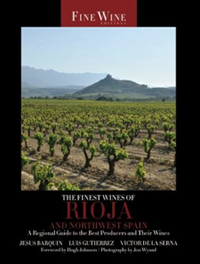The Finest Wines of Rioja and Northwestern Spain
 After so much discussion of the Parker-Miller-Campo imbroglio (see a thorough recap from Monday here), it’s refreshing to read about the wines of Spain again without thinking of “no pay – no Jay.”
After so much discussion of the Parker-Miller-Campo imbroglio (see a thorough recap from Monday here), it’s refreshing to read about the wines of Spain again without thinking of “no pay – no Jay.”
The new book, The Finest Wines of Rioja and Northwestern Spain, made me do just that. Up-to-date, with gorgeous photos, the book is by a trio of writers and tasters, well-known in Spain and possibly outside: Jesus Barquin, a criminology professor and sherry lover whose passion led him to co-found Equipo Navazos, a boutique producer of excellent sherries; Luis Gutierrez who recently started contributing to jancisrobinson.com; and Victor de la Serna, deputy editor of El Mundo, a leading Spanish daily, who heads El Mundo Vino.
Although the book is largely a collection of 85 producer profiles, the authors open the book with several good discussions, one about the grape varieties (they acknowledge the resurgence of indigenous varieties in the northwest) and another about traditional versus modern winemaking. This latter discussion is of most importance in Rioja where modern style has been ascendant. The authors dispute the notion that the modern style of dark, extracted, fruity wines has been a “curse” for the region and are surprisingly accommodating of it saying that the best of the moderns “will in turn become classics.” I guess it would have been a short book if they didn’t adopt a non-partisan, ecumenical stand on the modern-traditional issue. They also admit that their personal collections have many examples of traditional producers from the best vintages.
The profiles bring the producers to light in one to six pages and include traditional producers (Lopez de Heredia and La Rioja Alta), modern (Roda), mixed (Muga) and up-and-coming (Olivere Rivière). They also discuss Txakoli, Albarino and wines from Ribeira Sacra and Bierzo. Throughout the book, they highlight a top wine from a producer with a star; I agreed with enough of their starred wines that I will look for some other of their suggestions to try. They also tuck in a list of restaurants and shops with good supplies of aged Rioja (though how many will be modern?) that would be helpful to travelers to the region. In fact, with its wealth of practical information and advice, I wouldn’t head to the region without it.




On December 14th, 2011 at 12:56 pm ,Tom Riley wrote:
If going to Haro, to visit Muga and Lopez and Cune and others, Los Augustinos is the place to stay. Excellent rooms and service and a stone’s throw from most of the wineries and good eating spots as well. Was there a few summers ago and could not have had a better time.
Good piece. I’ll add the book to my Christmas list!
Tom
On December 15th, 2011 at 9:08 am ,Derek wrote:
Best book on Spanish Wine (Rioja, etc.) in a long time. And written by well-regarded, knowledgeable locals! (with no disrespect to John Radford whose coverage of Spain is always first rate). This book is long overdue.
On December 15th, 2011 at 12:23 pm ,Dr. Vino wrote:
Thanks for the accommodation tip, Tom!
Derek – Yes, true, there has been an unfortunate dearth of books on Spain. There’s exciting stuff going on so I’m pleased that this book is now on retailers’ shelves.
On December 21st, 2011 at 1:36 pm ,José wrote:
Tyler:
Nice review on the book. It is a top notch effort by three of the most knowledgeable and experience tasters in the Spanish wine scene. It will be extremely hard to find more qualified guys than any of them.
This book is a must buy for any Spanish wine enthusiast or anybody that is planning a trip to any of the regions included in this book. Most of the restaurants recommended have a good amount of older vintages of classic Riojas. They also have plenty of modern Riojas, but in many cases they are as expensive or more expensive than the older ones. Stores in Spain do not have that much supplies of older vintages and provenance of older vintages (20 years +) in stores is a little bit sketchier than in the restaurants.
The authors’ notion that the best of the modern wines “will in turn become classics†is pretty accurate based on my own experience of two decades of Spanish wine drinking. The problem is that some of those modern styled wines are very tasty when released and in the current culture of instant gratification very few people cellar them for more than a handful of years. Another issue is that a lot of folks have not tried any of the classics like Heredia from barrel one or two years from its vintage and realize how tannic and backward some of them could be. The classic wines are released when the winery feels they are ready to drink sort of like a LBV or Colheita port, while most of the modern ones are released a little after bottling following a Vintage port model.
The best examples of the first modern Riojas (1994-1996) are starting to turn into classic Riojas now. Although very tasty now, the ones from the 2001 vintage will require a little more patience than the 1994-1996 trio based on recent tastings.
FWIW, VÃctor De la Serna is also the owner of Finca Sandoval.
SALUDos,
José